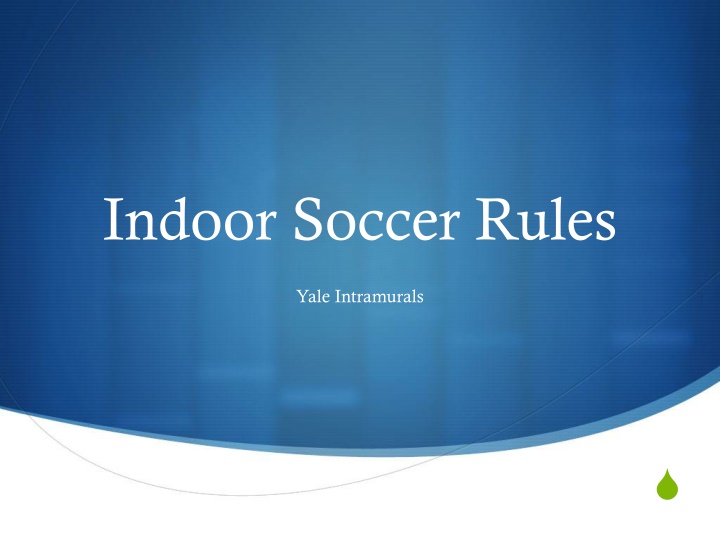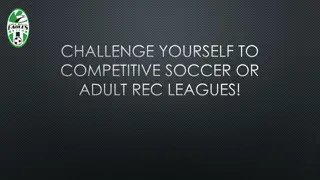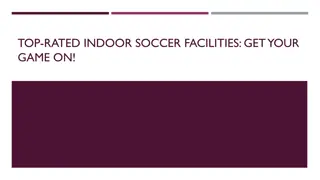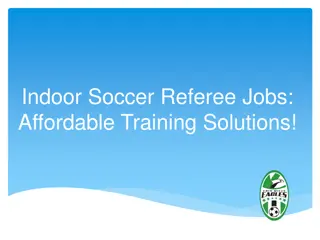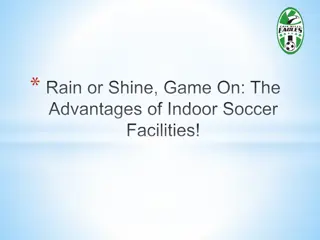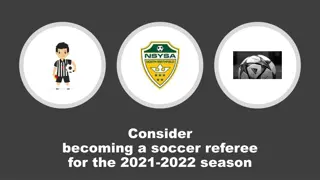Comprehensive Guide to Yale Intramurals Indoor Soccer Rules
This comprehensive guide covers the rules and regulations of indoor soccer for Yale Intramurals. Topics include game structure, team requirements, late policies, slide tackling and offside penalties, goalkeeper rules, and in/out of bounds play. Each section provides detailed information on how the game is played and what actions are allowed or penalized. Whether you are a player, coach, or spectator, this guide will help you understand the intricacies of indoor soccer at Yale University.
Download Presentation

Please find below an Image/Link to download the presentation.
The content on the website is provided AS IS for your information and personal use only. It may not be sold, licensed, or shared on other websites without obtaining consent from the author.If you encounter any issues during the download, it is possible that the publisher has removed the file from their server.
You are allowed to download the files provided on this website for personal or commercial use, subject to the condition that they are used lawfully. All files are the property of their respective owners.
The content on the website is provided AS IS for your information and personal use only. It may not be sold, licensed, or shared on other websites without obtaining consent from the author.
E N D
Presentation Transcript
Indoor Soccer Rules Yale Intramurals
Indoor Soccer: The Game The game consists of two 20-minute periods Each game will have a brief 5-minute intermission The clock only stops in the last three minutes of the second half for goals, injuries, and unusual delays. During the regular season no overtime shall be played. During playoffs, one 5-minute overtime will be played, and if the contest is still tied shootouts will determine the winner.
Indoor Soccer: The Team Each team will consist of: A minimum of 4 players with at least 1 female players A maximum of 5 players with at least 2 female players Unlimited substitutions are permitted
Indoors Soccer: Late Policy 10 minutes after the scheduled start time: The game will be reduced by 10 minutes and the opposing team will be awarded one goal and possession of the ball at mid-court for an indirect kick. 20 minutes after the scheduled start time: The game will produce a forfeit and two extra goals will be awarded to the present team.
Indoor Soccer: Slide Tackling & Offside Penalties Slide tacking is illegal and awards the opposing team a free kick. Slide tackling is defined as a player who attempts to take the ball away from an opposing player, by deliberately leaving his/her feet and sliding along the ground with one or two legs extended to push the ball away from the opposing player. There are NO offside penalties in indoor soccer.
Indoor Soccer: Goalkeeper Rules Goalkeeper Privileges: The goalies are allowed to hold the ball inside the three point arc; however, they are only allowed to hold to ball up to three seconds of clock time. When attempting to throw the ball, goalies may only roll the ball on the floor. Goalies are NOT allowed to drop kick, throw the ball in the air or punt the ball. If a goalie drop kicks, punts the ball or completes an aerial throw an indirect kick will be awarded to the opposing team
Indoor Soccer: In/Out of Bounds Play & Kick-ins A ball is out of play when it has entirely crossed the out of bounds line. The ball is also out of bounds if it strikes any part of the basketball backboards, supports, roofing, or walls located outside the boundary line. If the ball strikes any of these obstructions the referee will deem if there will be a goal kick or throw in to resume play. If the ball strikes the goal post, crossbar, or referee and remains in bounds then the ball is still playable. There are no throw-ins taken in indoor soccer The ball is kicked in at the spot where the ball completely crossed the sideline. After the kick-in, the kicker may not play the ball until it is touched by another player.
Indoor Soccer: Penalty Kicks A penalty kick is awarded for any infraction resulting in a direct free kick by the defending team committed inside the penalty box area (inside the free throw line). To take the kick, the kicker may place the ball anywhere on the penalty-mark line (top of the three point arc). The goalkeeper must stand, without moving his/her feet, on the goal line between the goal posts, until the ball is kicked.
Indoor Soccer: Goal Kicks A goal kick is awarded to the defending team when an attacker forces the ball to completely cross the goal line. The ball is placed on the ground at a point within the goal area nearest to where it crossed the goal line and is kicked in any direction from that point into the court of play beyond the penalty area. The goalkeeper may not receive the ball into his/her hands from a goal kick in order to thereafter kick it into play. The kicker may not play the ball until it is touched by another player. A goal may not be scored from a goal kick.
